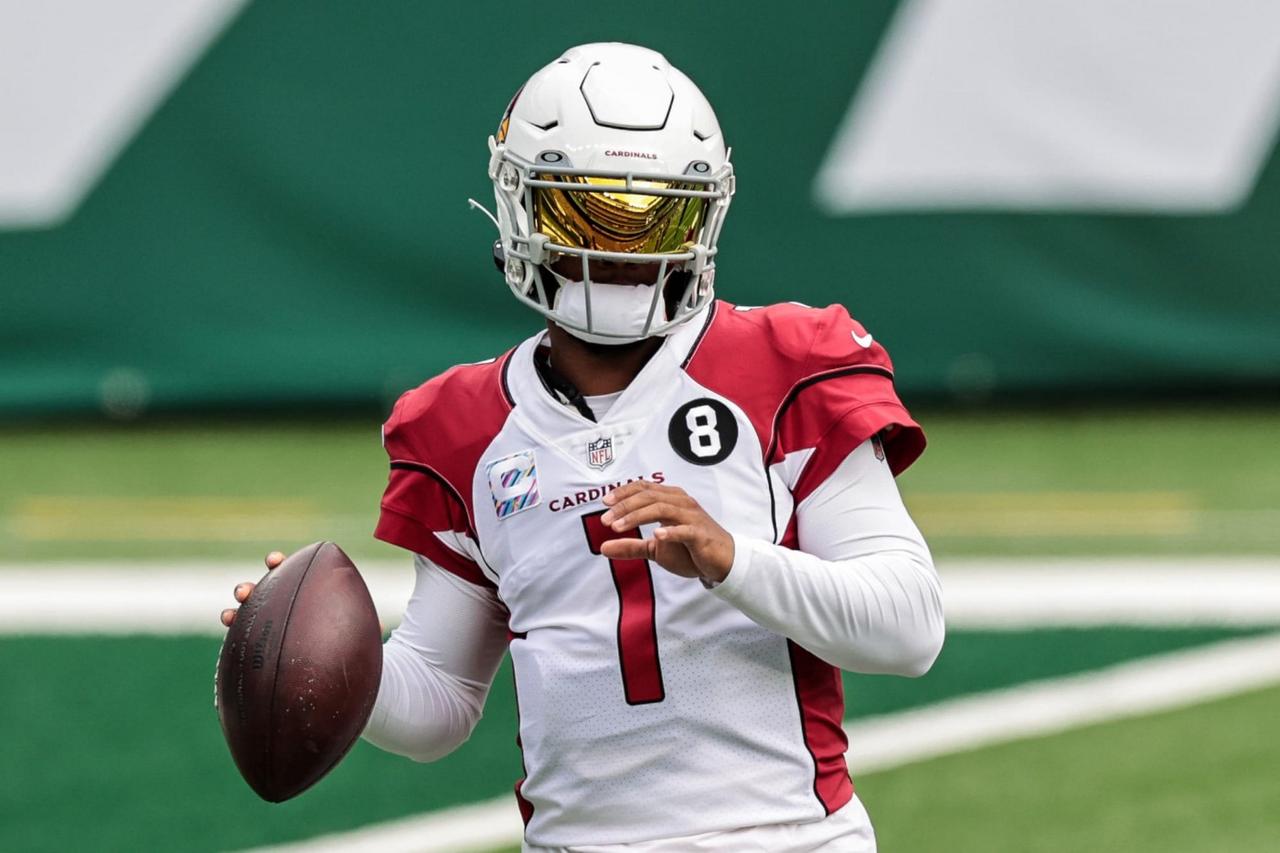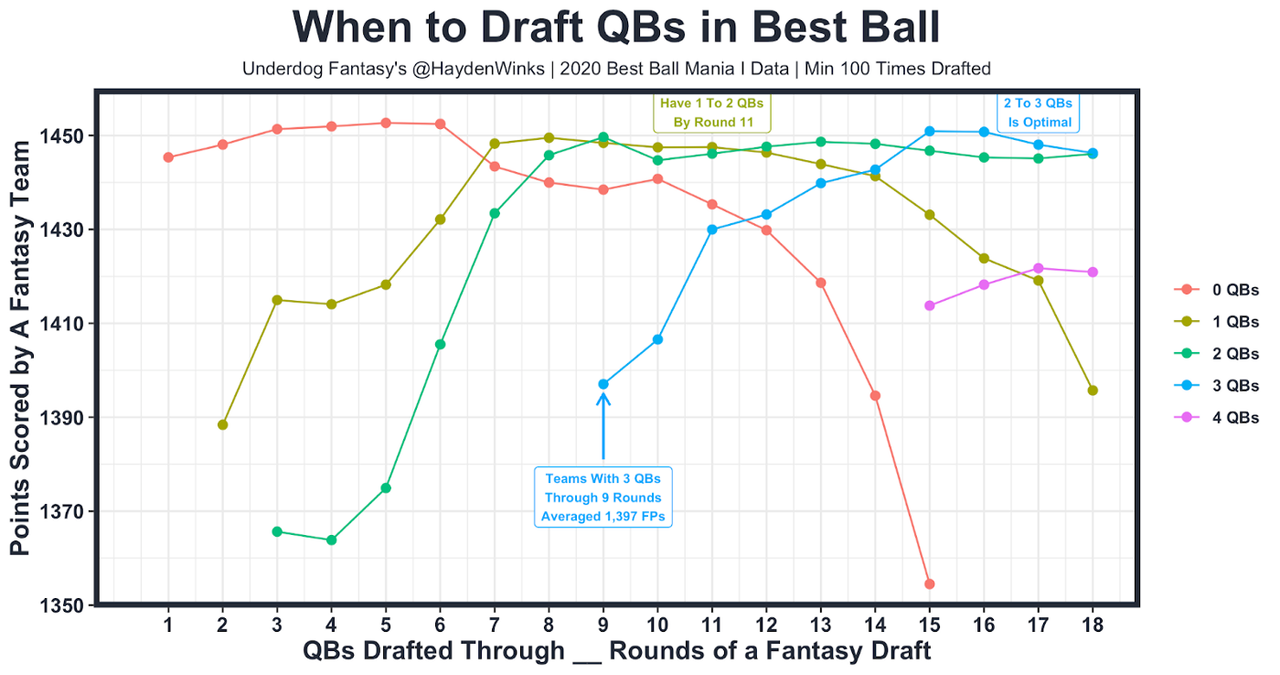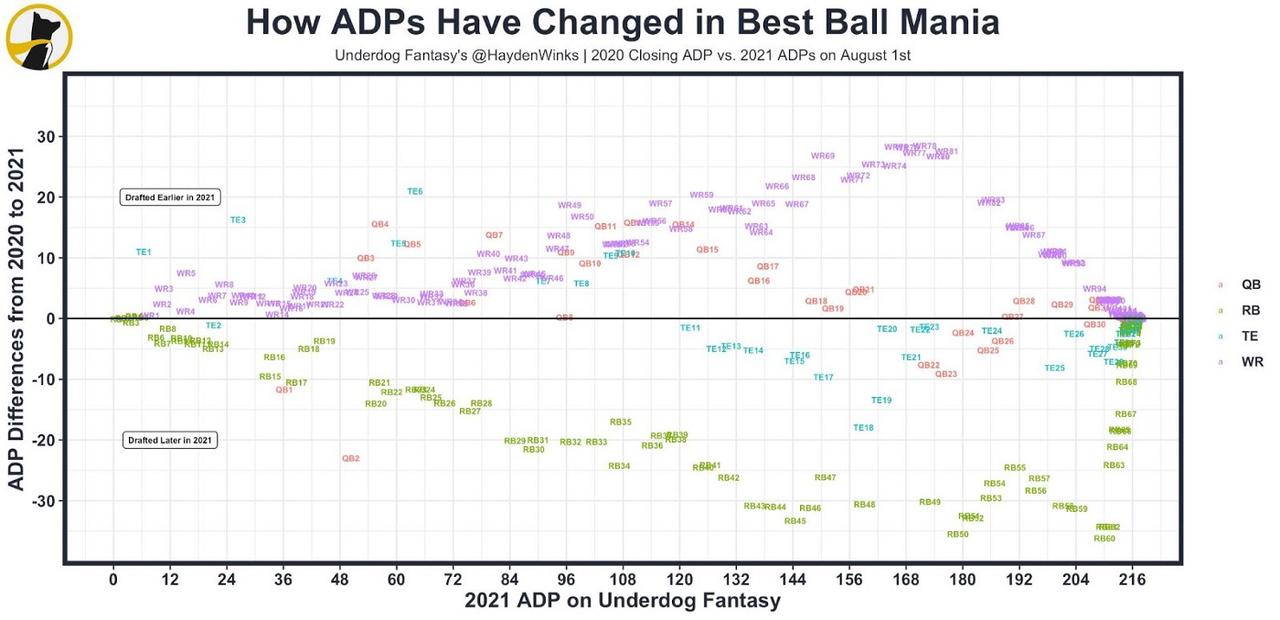When To Draft QBs In Fantasy Football

Combining Best Ball Mania I public data with our own intuition and best ball data from other sites, I think we can create roster construction edges already even if we aren’t 100% sure of what’s optimal in the infant stages of best ball. I’ve been reluctant to share 2020 data at the onesie positions (QBs and TEs) because it’s far more prone to small sample issues compared to positions where 70–100 players are being drafted (RBs and WRs). Today, I’m going to tackle QBs on Underdog Fantasy, but I’m less confident in these conclusions than I am with my RB conclusions and my WR conclusions.
Before we dig into the column, I want to welcome new Underblog readers with a $10 sign-up bonus on Underdog Fantasy. Either use this link or promo code ‘UNDERBLOG’ with any first-time deposit to get that sweet cash in your account.
When To Draft QBs in Fantasy Football

This chart shows us how many best ball points teams scored depending on how many QBs a person selected through all 18 rounds of last year’s Best Ball Mania I. The higher the dots are on the chart, the better the teams performed on average (which I’d argue correlates to top 5% outcomes). For example, in Round 9 teams with 3 QBs (blue) averaged 1,397 best ball points. That’s far less than teams who had 0 QBs (red), 1 QB (shit yellow), or 2 QBs (green) through the ninth round.
If we go to the last round, we find that it was clearly optimal to have either 2 QBs or 3 QBs at the end of drafts. Teams with 1 QB or 4 QBs averaged nearly 50 best ball points less, which essentially eliminates your chances of advancing into the best ball playoffs. But I want to stress that roster construction should not be viewed through the lens of the last round. The “roster construction path” is far more important than what’s optimal at the end of the draft in a vacuum.
Option #1 — Elite QB and Chill
Based solely on last year’s data (small sample size warning), it was best not to have a QB until at least Round 6 where the gap between 0 QB and 1 QB teams began to shrink. Based on opportunity cost, this makes a lot of sense to me and I’d expect this to be at least partially true in 5 years when we have more concrete data.
Now, this doesn’t mean we can’t select a QB in Round 5 right now, but we must be really smart about how we do it with evidence suggesting it’s a risky move. The way it can work is if we 1) stack that QB with his pass catchers, and 2) don’t commit more valuable draft capital into the position. If we’re drafting Josh Allen in Round 5 this year, it’s best to completely punt the QB2 spot in massive tournaments like Best Ball Mania II or the Puppy 2. By punt, I mean not draft our QB2 until Round 13 or so because we need to be earning back those RB/WR points we forwent by drafting Allen early.
Option #2 — The QB Double Dip
Between Rounds 8–13, there wasn’t much of a difference between how teams performed depending on if they had 1 QB or 2 QBs. Once again, this makes sense to me because teams with one elite QB could be successful and teams with 2 mid-range QBs can be successful. Based on the chart, I’d argue that Round 8 was the turning point where teams with 0 QBs were beginning to hurt themselves compared to teams that had drafted 1 QB (although there are certainly ways to combat this).
If this Round 8/9 area is where we’re committing to our QB1, then quickly double-dipping at QB seems like a great strategy because teams that still had 1 QB in Round 13 began falling compared to teams with 2 QBs (and this Round 13 data includes teams that drafted their QB2 in Round 13 despite having an elite QB, so we should be better off drafting our QB2 slightly earlier when we draft a mid-range QB1 as our QB1 instead of the elite QB1). In my “Ideal Draft” for the Underdog Fantasy Draft Guide, I selected Tom Brady in Round 10 and Trey Lance in Round 11. I like the ceiling/floor of Brady and his stacking options combined with Lance’s top-5 ceiling.
Option #3 — Three QB Builds
Drafting a QB3 on Underdog Fantasy has to be done smartly because it’s clearly suboptimal in some builds (like the two ones I just outlined). The chart from above shows that the absolute earliest a QB3 should be drafted is in Round 13 and that a QB3 wasn’t optimal in a vacuum until Round 15. In other words, the QB3 should only be reserved for our last four picks and only when our QB1 and QB2 are weaker.

What’s changed from Best Ball Mania I to Best Ball Mania II is prices. And this can’t go overlooked. Patrick Mahomes is a round cheaper, as is the QB2, but the QB3 to QB15 are all being drafted about one round earlier this year compared to 2020. A lot of this is justified after seeing the dual-threat QBs really take off last year, but this does mean that other strategies deserve some attention now that things are more priced in.
Going with 3 mid-round QBs seems viable in 2021, as long as one of the QBs we draft has reasonable top-8 fantasy QB upside. One example could be a Trey Lance (Round 11), Ryan Fitzpatrick (Round 14), and Ben Roethlisberger (Round 17) team. Lance offers the elite ceiling, while Fitzpatrick and Roethlisberger help out with adding more stacks, more points to bye weeks, and more floor overall as we look to advance out of our drafting round. Both Fitzpatrick and Roethlisberger also have random spiked weeks that could even bail us out in the fantasy playoffs, even if Lance is balling out in the back-half of the year.
When we’re debating between Roethlisberger (Round 17) or WR Marquez Callaway (Round 17), just ask yourself who has the higher starting-week potential for my team? The QB3 vs. my top 2 QBs, or the WR9 vs. my top 8WRs? Nailing these decisions help add to the best ball edge, and these decisions are too complicated to be answered in a generalized best ball column.